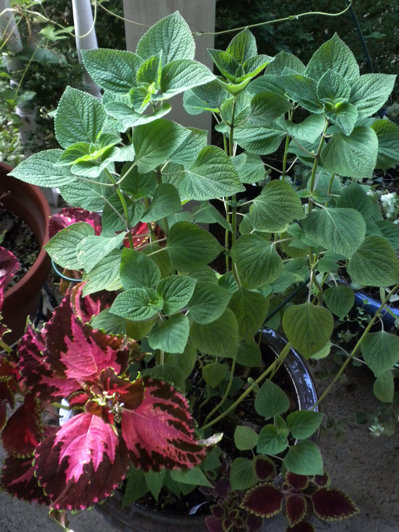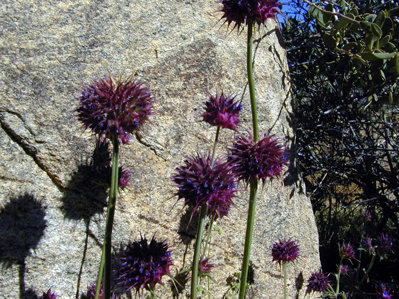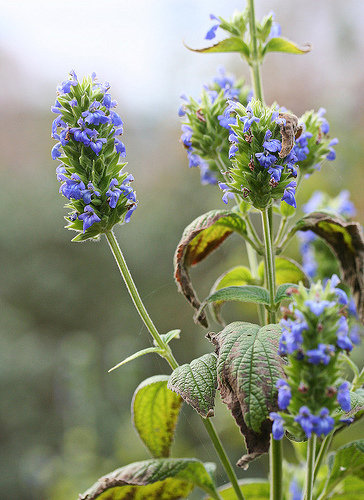





Nutritious Chia seeds come from Salvia plants (sages in the Mint family) and grow easily in the home garden. Chia plants produce incredibly healthy seeds, super high in omega-3's (like flaxseeds). Chia adds nutrition to your plate and interest to your kitchen garden, hummingbird garden and potted arrangements. Check out Chia!
When I told my husband I was growing Chia plants, he immediately recalled the U.S. television commercial for Chia Pets® and sang me the tune "ch-ch-cha-Chia." He asked, "Is it the same chia?" I asked myself the same question. For those of you who never heard of them, Chia Pets are terracotta figurines that grow sprouted chia as hair. They were popular in the 1980s.
At first I denied my chia salvias were the same as those used in Chia Pets. After all, my chia plants grew way beyond hair-like sprouts - maturing into beautiful, tall salvias with delicate blue corollas (petals) and textured leaves. Upon further investigation, I discovered there were several kinds of salvias that produce small poppyseed-sized chia seeds attractive both to wildlife and mankind and ours was one of them.
Part-1: Growing Chia, Chia Species and Seeds
Growing Chia
Growing in full or part sun, drought tolerant Chia readily self sows and is resistant to most garden insects and pests. Perhaps the hardiness of Chia comes from being a member of the mint Lamiaceae family. In particular, annual species within the genus that yield nourishing Chia seeds, include: Salvia hispanica, Salvia tiliifolia and Salvia columbariae.


 S. tiliifolia
S. columbariae
S. hispanica
S. tiliifolia
S. columbariae
S. hispanica
Chia Species
Salvia hispanica is the species grown commercially and the one used in Chia Pets®. Seeds from this species are small, oval shaped, black or white and grown around the world in Bolivia, Argentina, Australia, Ecuador, Paraguay and its native range in Mexico and Guatemala. S. hispanica plants require sandy loam soils and are day length sensitive. Flowering is determined by length of daylight (like tropical cultivars of Maize needing shorter days) frost becomes a factor, which is why commercial crops are grown outside the U.S., according to chia expert Wayne Coates, PhD.
I can vouch for Salvia tiliifolia, Tarahumara Chia as being care-free and easy-to-grow. Ours grows with little fuss and provides interest with 36-48-inch (90-120 cm) height and visibly textured leaves that remind me of a broader, more ovate version of Salvia guaranitica's leaves. A year after organically growing this Lindenleaf sage, self sown plants appeared in our stone driveway as hardy as the weeds. They were easily lifted and transplanted to wherever I wanted them, which included a pot for our partly shaded front porch and a pot in direct sun planted with cherry tomato plants. Another chia 'volunteer' is currently thriving in a garden raised bed alongside peppers. That plant, in particular, appears the tallest and fullest of them all, getting more sun and water.
Native to Mexico, Central America, Venezuela, Columbia, Ecuador and Peru,[1] Tarahumara Chia was introduced and is now established in the US in Texas, Arizona and Massachusetts.
Salvia columbariae exhibits a different appearance. Besides being a different species, it grows shorter: 12-18-inches tall (30-45 cm) and even half that height in the desert. Vibrant blue blooms appear in clusters separated by stem growth. Also known as golden chia, S. columbariae is among the many flora of California chaparral and woodlands native plant species. Golden chia grows well in the west from California to Utah and south to Northern Mexico.
Chumash Indians and other west coast California Native American tribes hand harvested wild S. columbariae chia, as well as other salvia species, including S. Carduacea - a thistle sage.[2]
Edible Chia Seeds
Thanks to a health conscious gift shop owner at Long Beach Island, NJ many years ago, I discovered chia seeds as food. On almost every visit to his shop, I would find him snacking on tiny gray and white seeds that I later learned were nutritious chia. Chia seeds offer nutrition, similar to flaxseed.
If it is bulk seeds you are after, and you do not have a lot of ground to grow numerous chia plants, it may be best to purchase bulk chia seeds. At my home we grow chia salvias for beauty and wildlife and let commercial chia seed producers do the heavy harvesting. Organic Chia seeds are available online and from Natural Food stores and gourmet markets.
Of the primary Chia Salvia species, S. hispanica is the most used commercially for seed. Chia seeds have become more popular over the years, especially with health conscious individuals, chefs and athletes.
Click here for part 2: Check out CHIA - an Indigenous Food
Click here for part 3: Check out CHIA - Super Seed Nutrition
Footnotes: [1] USDA GRIN
[2] Timbrook, Jan, Department of Anthropology, Santa Barbara Museum of Natural History. Chia and the Chumash: A Reconsideration of Sage Seeds in Southern California; Journal of California and Great Basin Anthropology 1986; vol 8 p50-64
Photograph Credits: thumbnail and S.tiliifolia photos Copyright ©2011 D.Wind. All rights reserved. S.columbariae Chia growing along Highway 195 in Joshua Tree National Park courtesy of Wikipedia, licensed under the Creative Commons Attribution-Share Alike 2.0 Generic license by Dawn Endico, Menlo Park, California. S.hispanica Inflorescences used with permission courtesy of Nuytsia@Tas
Chia Pet® is a registered trademark of Joseph Enterprises
Copyright © www.100flowers.win Botanic Garden All Rights Reserved